Wikipedia:Today's featured article/August 31, 2024 (edit | [[Talk:Wikipedia:Today's featured article/August 31, 2024|talk]] | history | protect | delete | links | watch | logs | views)
Rachelle Ann Go (born August 31, 1986) is a Filipino singer and actress. Known primarily for her work in theater, she has starred in musicals on Broadway and in the West End. She began her career as a pop artist in her native country, winning the television talent show Search for a Star in 2003. She has since released six albums. Go started her theater career in the Philippines, playing the lead roles of Ariel in The Little Mermaid (2011) and Jane Porter in Tarzan (2013). Her international breakthrough came when she was cast as Gigi Van Tranh in the West End revival of Miss Saigon in 2014. She gained further recognition for her portrayal of Eliza Schuyler in the original 2017 West End production of Hamilton. Go has also played Fantine in various stagings and tours of Les Misérables. Outside of music, she has had roles in the television series Diva (2010), Nita Negrita (2011), Biritera (2012), and Indio (2013). (This article is part of a featured topic: Overview of Rachelle Ann Go.)
Wikipedia:Today's featured article/September 1, 2024 (edit | [[Talk:Wikipedia:Today's featured article/September 1, 2024|talk]] | history | protect | delete | links | watch | logs | views)
Gothic boxwood miniatures are very small Christian-themed wood sculptures produced during the 15th and 16th centuries in the Low Countries, at the end of the Gothic period and during the emerging Northern Renaissance. They consist of highly intricate layers of reliefs made from fine-grained boxwood, often rendered to a nearly microscopic level. Of the approximately 150 surviving examples, the majority are statuettes, skulls, coffins, or spherical beads known as prayer nuts; some 20 are in the form of polyptychs, including triptych and diptych altarpieces, tabernacles, and monstrances. They typically contain imagery from the life of Mary, the crucifixion of Jesus, or vistas of Heaven and Hell. Each miniature required exceptional craftsmanship and may have taken decades to complete. Important collections are in the Art Gallery of Ontario, the British Museum, and the Metropolitan Museum of Art in New York. (Full article...)
Wikipedia:Today's featured article/September 2, 2024 (edit | [[Talk:Wikipedia:Today's featured article/September 2, 2024|talk]] | history | protect | delete | links | watch | logs | views)
Falcon's Fury is a freestanding Sky Jump drop tower attraction at Busch Gardens Tampa Bay, an amusement park in Tampa, Florida. Manufactured by Intaride, a subsidiary of Intamin, the ride is North America's tallest freestanding drop tower, at a maximum height of 335 feet (102 m). It is also the first drop tower to use 90-degree tilting seats, facing riders straight down through five seconds of free fall. They reach a speed of 60 miles per hour (100 km/h) before rotating back into a vertical position and decelerating at about 3.5 Gs. The ride's name is meant to suggest a falcon's ability to dive steeply at high speed to capture prey. Due to the height of the attraction, approval from the Federal Aviation Administration was required. Construction was delayed until 2013, and the opening date was also delayed by mechanical and technical issues. Falcon's Fury opened to park employees in August before a soft opening on August 16, 2014, and an official opening on September 2, 2014. (Full article...)
Wikipedia:Today's featured article/September 3, 2024 (edit | [[Talk:Wikipedia:Today's featured article/September 3, 2024|talk]] | history | protect | delete | links | watch | logs | views)
The Laysan honeycreeper (Himatione fraithii) is an extinct species of finch, first recorded in 1828, that was endemic to Laysan in the Northwestern Hawaiian Islands. Its length was 13–15 cm (5–6 in) with a 64–69 mm long (2.5–2.7 in) wing. It was bright scarlet vermilion with a faint tint of golden orange on the head, breast and upper abdomen; the rest of its upper parts were orange scarlet. The lower abdomen was dusky gray fading into brownish white. The wings, tail, bill, and legs were dark brown. The bill was slender and downturned. It was nectarivorous and insectivorous, gathering nectar and insects from flowers. The breeding season was probably between January and June, and the clutch size was four or five eggs. In 1903, domestic rabbits were introduced to the island and destroyed its vegetation. In April 1923, only three Laysan honeycreepers were found, one of which was filmed. On April 23, a sandstorm hit the island, and the last birds perished due to lack of cover. (Full article...)
Wikipedia:Today's featured article/September 4, 2024 ([[Special:EditPage/Wikipedia:Today's featured article/September 4, 2024 |edit]] | [[Talk:Wikipedia:Today's featured article/September 4, 2024 |talk]] | [[Special:PageHistory/Wikipedia:Today's featured article/September 4, 2024 |history]] | [[Special:ProtectPage/Wikipedia:Today's featured article/September 4, 2024 |protect]] | [[Special:DeletePage/Wikipedia:Today's featured article/September 4, 2024 |delete]] | links | watch | logs | views)
Battle Birds was an American air-war pulp magazine, published by Popular Publications. It was launched at the end of 1932, but did not sell well, and in 1934 the publisher turned it into an air-war hero pulp titled Dusty Ayres and His Battle Birds. Robert Sidney Bowen, an established pulp writer, provided the lead novel each month, and also wrote the short stories that filled out the issue. Bowen's stories were set in the future, with the United States menaced by an Asian empire called the Black Invaders. The change was not successful enough to be extended beyond the initial plan of a year, and Bowen wrote a novel in which, unusually for pulp fiction, Dusty Ayres finally defeated the invaders, to end the series. The magazine ceased publication with the July/August 1935 issue. It restarted in 1940 under the original title, Battle Birds, and lasted for another four years. All the cover art was painted by Frederick Blakeslee. (Full article...)
Wikipedia:Today's featured article/September 5, 2024 (edit | [[Talk:Wikipedia:Today's featured article/September 5, 2024|talk]] | history | protect | delete | links | watch | logs | views)
Titanis is a genus of Phorusrhacidae, or "terror birds". The extinct family of large, predatory birds originated in South America and inhabited parts of the present-day United States during the Pliocene. Like all phorusrhacids, Titanis had elongated hind limbs, a thin pelvis, proportionally small wings, and a large skull with a hooked beak. Estimates placed Titanis at 1.4 to 2 meters (4.6 to 6.6 ft) in height and over 300 kilograms (660 lb) in body mass. Phorusrhacids are thought to have been ground predators or scavengers, apex predators that dominated Cenozoic South America. They may have swallowed small prey whole or targeted larger prey with repeated strikes of the beak. Titanis likely preyed on mammals such as the extinct armadillo relatives Holmesina and Glyptotherium, equids, tapirs, capybaras, and other Pliocene herbivores. Titanis is unique among phorusrhacids in that it is the only one known from North America, crossing over from South America during the Great American Interchange. (Full article...)
Wikipedia:Today's featured article/September 6, 2024 (edit | [[Talk:Wikipedia:Today's featured article/September 6, 2024|talk]] | history | protect | delete | links | watch | logs | views)
The Frye Fire was a wildfire that burned 48,443 acres (19,604 ha) in Graham County, Arizona, United States, from June 7 to September 1, 2017. The fire was ignited by a lightning strike on Mount Graham, within the Coronado National Forest, and spread rapidly until it was mostly contained on July 12. The fire destroyed three buildings and briefly threatened the Mount Graham International Observatory. It cost $26 million (equivalent to $32 million in 2023) to contain and suppress, and involved more than 800 firefighters. There were no fatalities, but 63 firefighters were quarantined with strep throat. During seasonal rains beginning in July, ash and debris from the Frye Fire's burn scar washed off the mountain slopes, then clogged creeks and damaged infrastructure within Graham County. The fire particularly impacted the endangered Mount Graham red squirrel, whose remaining habitat on Mount Graham was devastated. (Full article...)






